by Tony Kliber, Lead Project Engineer-Precision Automation Components, Nexen Group, Inc., Vadnais Heights, Minn.
Roller pinion technology can overcome the limitations of rack and pinion systems, providing advantages for precision motion control applications.
Linear drive systems are a critical part of a variety of manufacturing processes, from machine tooling and glass cutting to medical and aerospace applications. Conventional rack and pinion systems have traditionally been the solution of choice, but their limitations can impede production goals and efficiency initiatives. Roller pinion systems are designed to overcome the performance challenges associated with rack and pinion systems and to provide the motion control these applications demand without suffering expensive errors. Before installing a linear drive system, you should know what technologies are available, as their individual strengths and limitation can significantly impact overall production costs.
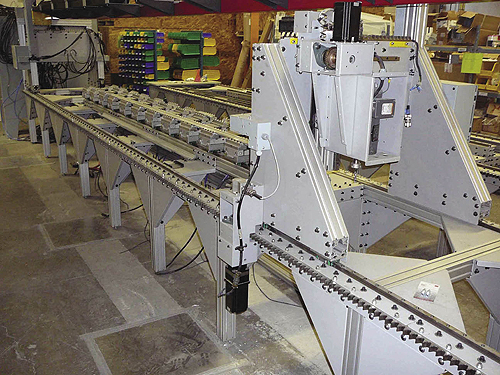
The roller pinion system delivers a highly precise, low-maintenance, cost-effective alternative to rack and pinion systems for motion control applications.
Conventional Rack and Pinion Systems
A rack and pinion system converts rotary motion into linear motion. It’s made up of a round, toothed pinion and a flat rack. The machined profile of the pinion is engaged with a matching profile in the rack. Typically, the pinion is driven by a motor, causing it to rotate, and the meshing teeth then translate the rotary motion into linear motion. Due to its engineering, traditional rack and pinion systems require clearance between the rack teeth and gear teeth to prevent jams and excessive wear. If this isn’t done, small changes in the environment could have damaging consequences. For instance, a temperature change as little as ten degrees causes the gear teeth to expand, which could potentially lock up the system. While this clearance is necessary to avoid system lock-up, it also results in backlash, which is equivalent to system error.
To counteract this backlash in high-precision applications, manufacturers add a second component that compensates for the clearance. This can be done by adding a second pinion to the drive system or using a split pinion system. In a split pinion system, where a pinion is essentially cut in half, a spring is positioned between the two halves. During operation, as the split pinion moves along a rack, the first half of the pinion pushes on one side of a rack tooth and the other side on the next rack tooth.
Though the split pinion system does eliminate backlash caused by tooth clearance, it can be expensive and accelerate wear to the structure. With one half of the system acting as a control element, the split pinion is working with a limited torque capacity. Efficiency is also reduced by the loss of motion created when the drive dynamics have to overcome the friction caused by the force of the spring.
Along with backlash, traditional rack and pinion systems are vulnerable to other limitations that can impact overall production efficiency and accuracy. For instance, these systems require frequent, dedicated maintenance to ensure continued performance. Tooth wear decreases positional accuracy, and the system must be continuously lubricated to slow this deterioration. Unfortunately, the need for constant lubrication can also lead to extraneous problems, such as contaminating products or creating a mess on the plant floor. Rack and pinion systems can also suffer from noise, vibration, particle emissions, velocity ripple and tooth fatigue.
Roller Pinion System
Roller pinion technology is an alternative to traditional rack and pinion systems. Even though they share a similar design principle with the rack and pinion, roller pinion systems replace the traditional tooth profile with bearing-supported rollers, acting like a cam and follower rather than a spur gear.
The unique tooth profile means that there’s no need for clearance between the rack and pinion. The roller pinion’s modified circular tooth profile design ensures at least two rollers remain loaded in opposition at all times to effectively eliminate backlash. Rollers meet the rack with a tangent path and smoothly roll down the tooth face, preventing tooth slap, sliding friction, fatigue, noise and precision errors associated with a traditional rack and pinion designs.
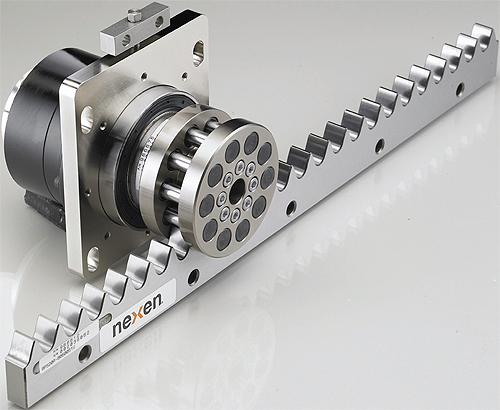
A roller pinion system replaces the traditional tooth profile of a rack and pinion system with bearing-supported rollers.
Because each tooth profile is precisely measured to ensure high positional accuracy and eliminate cumulative error, roller pinion technology is engineered to defeat backlash and any subsequent errors resulting from backlash. Therefore, the system provides a consistent torque capacity to provide the desired accuracy and repeatability, without requiring the addition of a second pinion.
In addition, by not needing two pinions, roller pinion systems don’t have to compensate for any performance limitations exacerbated by the addition of a spring element. For instance, when a system must work to overcome the friction caused by the force of a spring, it suffers reduced efficiency. The inherently smooth, rolling motion of the roller pinion systems delivers a low-friction operation that actively improves efficiency, up to 99 percent when converting rotary to linear motion.
A Rolling Motion that Pays
In today’s manufacturing environments, time is money, and any production halt, machine maintenance and equipment repair means lost profitability. The way a traditional rack and pinion operates invites jams, as one pinion tooth has to push off of one side of a rack tooth and instantly move on to the next side of the tooth. Alternatively, the unique rolling design of the roller pinion engages multiple tooth flanks simultaneously—always in opposing directions—while also allotting clearance between the other. This ensures a continuously smooth motion that prevents jams as well as unnecessary, and costly, lost production.
Because the roller pinion system can perform high-quality, backlash-free motion control without the need for a secondary system, the cost of implementation is lower than with a split pinion system to achieve similar results. Along with lower initial investment expenditures, the intrinsic durability of roller pinion technology ensures improved longevity and fewer maintenance requirements, which saves on equipment repair/replacement and labor expenses for the life of the system.
Though no system can be truly maintenance free, roller pinions minimize the need for continuous lubrication while still suffering less wear than other technologies. Further, for applications that run at speeds less than 30 m/min, roller pinion systems can perform lubrication-free. When operating even at top speed, the extremely low friction design generates minimal heat to avoid excessive wear on components. While pinions in both systems do require periodic replacement, with roller pinion technology, users only have one pinion to replace as opposed to a more complicated and time consuming split pinion system.
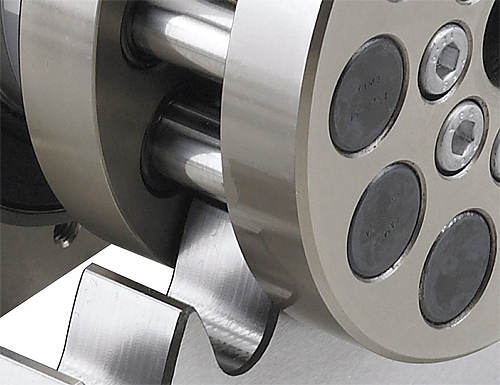
With its modified circular tooth profile design, the roller pinion system ensures at least two rollers remain loaded in opposition at all times to effectively eliminate backlash.
In addition to the direct costs of equipment wear, machine designers should also consider the indirect consequences. As a traditional rack and pinion system deteriorates, positional accuracy and/or torque diminishes, requiring operators to compensate to avoid production errors that can have significant impacts on product quality and process efficiency. To prevent any performance loss attributable to wear, roller pinion systems are engineered to retain accuracy and torque for life, eliminating the need for any compensation strategies.
Manufacturers are constantly looking for ways to encourage profitability and retain customer satisfaction by cutting costs and sustaining product quality consistency. With the number of industries and applications relying on precise linear motion and the part it plays in machine operation, the accuracy, longevity and durability of motion control components have never been more important. Roller pinion technology combines these key attributes for a linear drive system that is engineered to promote productivity.
Nexen Group, Inc.
www.nexengroup.com
Filed Under: Factory automation, LINEAR MOTION

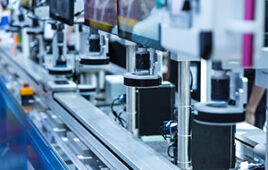

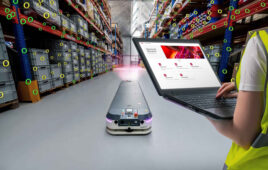
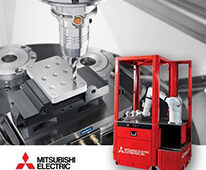
Lots of inaccurate statements about split-pinions and rack & pinion drives in this article.
Lots of inaccurate statements about split-pinions and rack & pinion drives in this article…
Hi
i would be interrested for that pinion As. I am working on 4m cnc
I need super long system